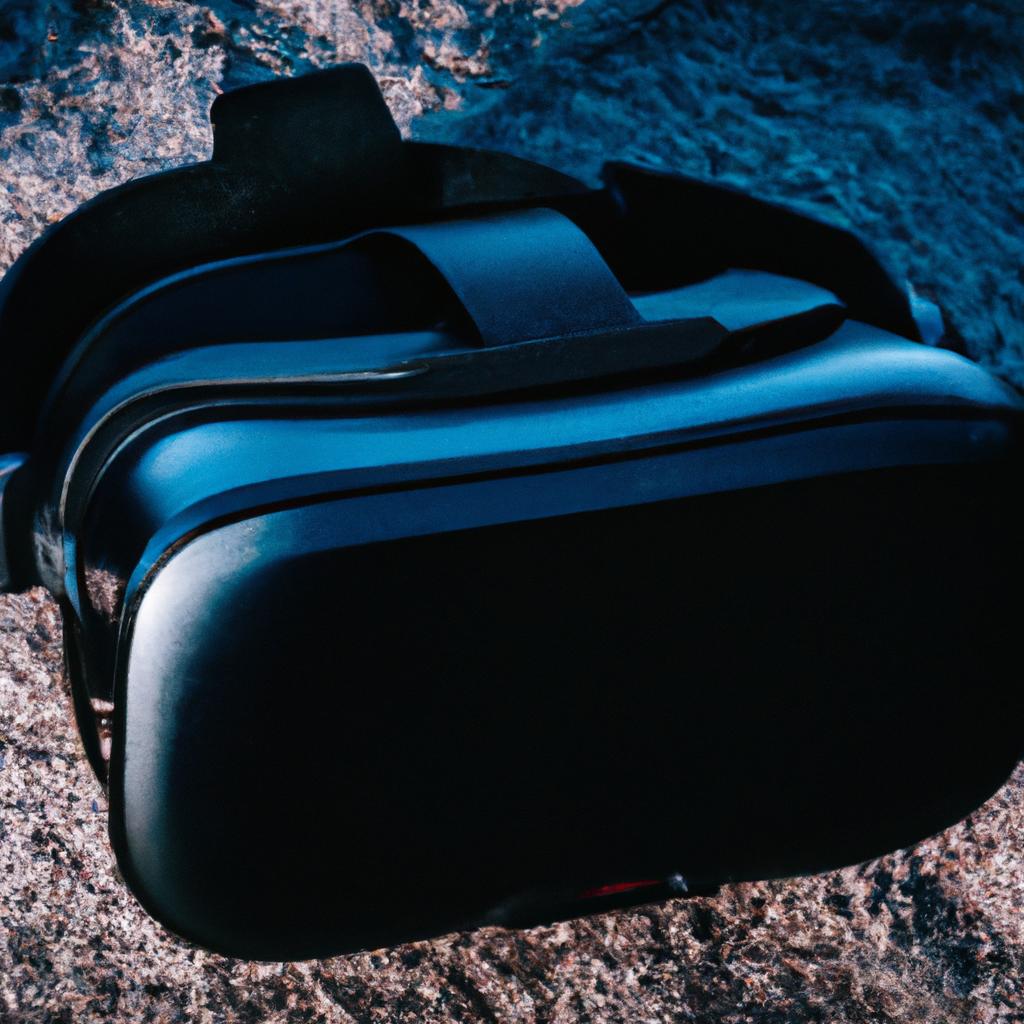Introduction to the Future of VR and AR in Sports
Virtual Reality (VR) and Augmented Reality (AR) are technology based tools that create immersive, digital environments for people to interact with. They are used in a variety of different applications, including in sports.
The use of VR and AR in sports is becoming increasingly popular, as it has the potential to improve many aspects of training, playing, and enjoying sports. In this guide, we will discuss the benefits, professional and amateur applications, challenges, solutions, and outlook for VR and AR in sports today.
What is Virtual Reality (VR) and Augmented Reality (AR)?
Virtual Reality (VR) is an immersive experience that involves a simulated environment created with computer technology. A person can interact with a VR environment by wearing a headset that covers their eyes and blocks out any outside distractions. The user can then look around, move their hands, and even speak to the environment as if it was real. AR stands for Augmented Reality, which combines the physical world with virtual elements that are projected onto the environment. Through the use of sophisticated visual effects, holograms, and audio statements, AR can make the real world come alive in new ways.
How is VR and AR being used in Sports Today?
Virtual Reality (VR) and Augmented Reality (AR) are increasingly becoming more popular in the world of sports. From allowing users to take a virtual tour of their favorite stadium, to providing detailed 3D visualizations of professional plays, these technologies are enabling new interactive experiences for athletes, spectators, and anyone else interested in the sports industry.
Professional sports teams are now embracing VR and AR technologies to provide more immersive experiences for their followers. For example, NBA teams like the Cleveland Cavaliers and the Golden State Warriors have invested in immersive video solutions that offer fans an up close and personal view of the action on the court. Major League Soccer has also explored using VR to help referees make better decisions in critical moments.
At the amateur level, VR and AR are being applied to a variety of sports such as golf, baseball, and soccer. By overlaying data from sensors on players’ uniforms, coaches can gain real-time insights into a player’s performance during practice sessions. This helps them to make more informed decisions and identify areas for improvement in their athletes.
It’s clear that these emerging technologies are having a huge impact on the world of sports. Both professional and amateur athletes are keen to explore the possibilities offered by VR and AR, and their application to sports is only going to increase.
Benefits of VR and AR for Athletes
Virtual Reality (VR) and Augmented Reality (AR) are tools that allow athletes to enhance their performance. By immersing themselves in a simulated environment, athletes can practice and improve without having to leave their home. Not only does this give them more time to train, but it also gives them a safe, controlled environment in which to practice.
VR and AR can help athletes to familiarize themselves with a playing field or court, giving them a better understanding of the space. This can be especially useful for sports like soccer, where players have to be aware of their surroundings and react quickly to changes in play. AR can even help improve reaction speeds by overlaying stats and information onto the field of play.
Furthermore, AR and VR allow for coaches and athletes to review game footage in greater detail. By being able to pinpoint moments in a game to review individually, they can better analyze and hone individual techniques. This improved understanding of the game is invaluable for any athlete looking to improve their performance.
Professional Sports Examples
Professional sports teams have begun to trial and implement the use of Virtual Reality (VR) and Augmented Reality (AR) as part of their training regimes. They see the potential of this technology to give athletes the edge they are looking for in the competitive world of sport. Teams such as the NBA’s Chicago Bulls, MLS’s LA Galaxy, and the NFL’s New England Patriots have all begun to trial or fully implement virtual reality into their programs.
In tennis, coaching staff have developed VR simulations that allow them to review a player’s performance in real-life scenarios against real opponents. This has allowed coaches to identify potential weaknesses in their players’ techniques, and develop individual strategies to help them improve. In addition, the use of AR is being trialed by both the ATP and WTA Tours, with the potential to provide real-time data and analysis during a match.
VR and AR are also being used in team sports like football. In both American and European football, coaching staff are using VR simulations to analyze opponents’ plays and develop strategic solutions. AR is also being used to present on-field data to coaches and players. This allows coaches to provide real-time feedback on the game, and make alterations quickly.
Applications of VR and AR in Amateur Sports
As technology advances, the use of Virtual Reality (VR) and Augmented Reality (AR) is being explored in amateur sports as well. While some professional teams may have access to more advanced technologies, amateur athletes are quickly catching up and beginning to utilize these tools for improved training and performance.
For example, athletes can use virtual reality simulation tools to visualize themselves performing their sport. This allows them to practice techniques more precisely and develop better muscle memory. Additionally, some athletes have even started to use AR apps to look up real-time feedback on specific techniques or plays. By doing this, they can gain an extra edge over their competitors.
Furthermore, some coaches are using VR/AR to provide individualized training. For example, some coaches are now able to record video of a athlete’s movements and analyze them with a VR platform. This helps them identify areas of improvement and tailor individual drills for each athlete.
Overall, VR/AR has revolutionized the way amateur athletes train and compete. With the availability of affordable tools, more and more amateur athletes can experience the benefits of VR/AR technology.
Development and Manufacturing of VR/AR Gear
With the widespread popularity of virtual and augmented reality technology, it stands to reason that the gear necessary to use it would have to be developed and manufactured. Companies such as Oculus, Microsoft, Sony, and HTC are all working diligently to bring the best and most advanced products to the market. They are also inventing new and improved technologies that make these experiences even better.
Each company is taking a slightly different approach to their VR/AR gear, focusing on their own strengths and strengths of the market they are targeting. For example, Microsoft has focused on making their product accessible to the widest audience possible, while Sony is creating a more immersive experience that is tailored to the gaming industry.
The development and manufacturing of this gear is constantly evolving, and companies are always striving to make the user experience even more realistic and exciting. As the technology continues to develop, so too do the options for consumers, resulting in better quality VR/AR gear that is also more affordable.
Challenges in Introducing VR/AR in Sports
The introduction of Virtual Reality and Augmented Reality (VR/AR) in sports has the potential to revolutionize the industry. However, there are some challenges that must be considered before it can become mainstream.
One of the most significant barriers to entry into using VR/AR in sports is the cost associated with the technology and equipment. VR/AR requires a large amount of hardware, software, and other components that can be expensive for amateur and professional sports organizations to purchase and maintain. Additionally, many of the available headsets and devices may not be compatible across different platforms.
Another challenge that needs to be addressed is the development of appropriate content. Sports organizations will need to create interactive, engaging, and immersive experiences that users can enjoy. This includes developing content that works well with the technology, as well as creating attractive and intuitive user interfaces. Additionally, sports organizations will need to ensure that their content is safe, secure, and compliant with any applicable laws and regulations.
Finally, there is a need for increased education and awareness about the benefits of VR/AR in sports. While many athletes and sports fans will be excited to experience new technology, others may be hesitant or unsure of how to use it. Sports organizations will need to provide clear and comprehensive resources to explain how VR/AR can be used in sports, as well as the potential benefits of incorporating the technology.
Solutions to Overcome Challenges
When it comes to using VR and AR technology in sports, there are several challenges and obstacles that must be addressed. Fortunately, there are solutions that can help make the transition seamless and beneficial for athletes and fans alike.
One possible solution is to invest in better hardware that can respond quickly to the needs of the user. High-end VR and AR headsets need to be made more affordable so that it is accessible to the general public. Furthermore, bringing more companies on board to create sports-specific content can help bring fresh ideas and perspectives into the sport.
Lastly, training programs for coaches and athletes need to be developed to help them become comfortable with using the technology as part of their training regimen. This will ensure that every athlete is adequately equipped to take advantage of the latest and greatest technology.
Present and Future Outlook for VR/AR in Sports
Virtual Reality (VR) and Augmented Reality (AR) are becoming increasingly popular within the sports industry. Already, pro leagues have experimented with combining these technologies with their sports broadcasts, and many professional athletes have used the technology to gain a competitive edge in training. Though still early in its development, the potential applications and opportunities for VR and AR in sports — both professional and amateur — are truly exciting.
For professionals, VR and AR offer solutions for analyzing data, studying competitors, and aiding in decision-making. For amateurs, it can help teach skills and provide an interactive, engaging experience. Additionally, these technologies could revolutionize sports broadcasting, allowing viewers to experience the game from unique angles.
The future of VR and AR in sports is likely to include more sophisticated data analysis and enhanced fan engagement. As the technology advances, VR and AR will undoubtedly have an even greater impact on the industry. Many predict that these technologies will help revolutionize how sport is viewed, practiced, and enjoyed worldwide.
Additional Potential Uses of VR/AR in Sports
Sports and athletics have long been seen as an opportunity to bring people together and experience the thrill of competition. With the rise of virtual reality (VR) and augmented reality (AR), new possibilities are being explored for revolutionizing the sporting experience.
VR and AR have already been used in sports in a variety of ways, such as for training, broadcasting, and marketing purposes. But there are even more uses that are beginning to develop in recent years. Let’s explore some of the additional potential uses for VR and AR, and how they can take sports to the next level.
- Augmented Stadiums: One potential use of AR could be in creating an augmented stadium. This idea would involve placing augmented reality markers around the stadium that display dynamic content. For example, a player’s stats could be shown in real-time on the field or viewers could get detailed replay angles of a particular play.
- Immersive Experiences: With VR, fans can have an immersive experience at sporting events. They can use the technology to see what it’s like to be in the stands or on the field. Fans can also take part in simulated versions of the sport, such as a golf course or race track.
- Fantasy Gaming: Fantasy sports have been popular for years, but with VR and AR, the experience could be taken to a whole new level. Players could create their own teams and compete against each other in simulated versions of the real game.
- Data Analysis: VR and AR can be used for data analysis by providing coaches and players with a realistic view of the game. Analyzing data from past games and matches can help athletes and coaches make more informed decisions about how to adjust their strategies.
- 360° Viewing: With 360° viewing, fans can get a panoramic view of the game. This feature would allow them to watch from all corners of the field or court, giving them a unique perspective on the action.
- Enhanced Training: Training sessions can be enhanced with the help of VR. Players can practice their techniques in a virtual environment, allowing them to improve their skills and prepare for upcoming games.
As technology advances, it is likely that more uses for VR and AR in sports will arise. They can provide new ways to engage with the game, allowing for more immersive experiences and better analysis of data. The potential for these technologies in sports is truly exciting, and we can only wait to see how they will be used in the future.
Availability and Accessibility of VR/AR in Sports
Virtual reality (VR) and augmented reality (AR) technology are becoming increasingly accessible and more widely available in sports. This has made it easier for athletes to access the latest in-game training tools and experiences that can help them improve their performance and gain a competitive edge.
VR and AR headsets are now available for purchase in some stores, while other companies offer packages designed specifically for use in sports. There are also apps and programs available that can be downloaded to tablets or smartphones, allowing users to access virtual environments tailored to their needs.
The rapidly expanding market for VR and AR equipment has also allowed people with limited budgets to access the technology more easily. This has enabled amateur athletes to start using VR/AR technology without breaking the bank.
Limitations and Issues with VR/AR in Sports
The introduction of virtual and augmented reality (VR/AR) in sports has the potential to revolutionize the way we experience sport, but there are still some challenges that need to be addressed.
Cost is one of the key issues with VR/AR in sports; many of the technologies are expensive and require additional hardware and software to operate properly. Furthermore, there is a lack of standardization across platforms, making it difficult for users to move between different systems.
Another issue is accessibility. While VR/AR technology is becoming increasingly mainstream, much of the population doesn’t have access to the necessary equipment or resources. This presents a significant barrier to wider adoption of the technology.
Finally, there is an ethical concern with the use of VR/AR in sports. It is important to consider how the technology affects athletes’ performance and how using it could lead to an unfair advantage for some teams or players.
Conclusion
The Future of VR and AR in Sports is truly an exciting prospect, with a massive range of possibilities that have just begun to be explored. With the development of more advanced technology, there are limitless opportunities for athletes, teams, and viewers alike to enhance their sports experience through immersive technologies. The convenience, accessibility, and affordability of VR and AR will facilitate further growth of these technologies in the sports world, allowing for a new spectrum of enhanced entertainment experiences for everyone involved.
VR and AR have the potential to revolutionize the sports industry, from professional to amateur levels. With the right strategies in place, these emerging technology solutions can overcome existing challenges and take sports into a more interactive, engaging, and entertaining future.
comments: 0











